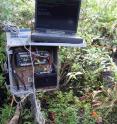Restoring coastal wetlands? Check the soil
Rising sea levels and coastal development are threatening coastal freshwater wetlands with saltwater intrusion. While most ecosystem restoration projects have focused on surface water and groundwater, new research finds that conditions in the vadose zone, the unsaturated soil below the surface but above the water table, are of particular importance to seedling survival in coastal floodplain ecosystems. Scientists at the University of Florida, the South Florida Water Management District (SFWMD), and the Florida Park Service investigated key measurements of the vadose zone, soil moisture, and porewater salinity, in a historically freshwater floodplain forest of the Loxahatchee River in southeastern Florida. Reduced flows have resulted in the loss of bald cypress communities in favor of drier, more salt-tolerant species.
Combining this new information with surface water, groundwater, and meteorological data allowed the team to develop hydrological relationships that drive ecosystem changes and inform proposed restoration and management plans. Results from the study (funded by the SFWMD) are published in the September-October 2010 issue of the Journal of Environmental Quality.
The researchers measured soil moisture and porewater salinity for four years at two sites – one in an upstream, freshwater location and one in a downstream, tidal area. The team was particularly interested in determining the relationship between soil moisture and river levels to determine whether proposed restoration flows would provide good conditions for of bald cypress seeds, a valued ecosystem component in the area. A second major research goal was to explain the distribution of freshwater and salt-tolerant plants in the floodplain based on observed salinities.
The unique data collection allowed researchers to measure differences in vadose zone conditions between sites and over a wide range of climatic conditions (two years with above-average rainfall, followed by two years of extreme drought). They found that soil moisture in upriver areas can be closely predicted based on river level and topographic elevation in the floodplain.
The authors developed a calculator for land managers to estimate average soil moisture under different river flow conditions during restoration efforts. In downstream areas, river levels that consistently saturate the soil will likely limit seed germination and seedling survival to isolated high points.
The salinity tolerance threshold for bald cypress, 2 parts per thousand (ppt), was rarely exceeded in upstream areas, but was exceeded for considerable durations in downstream areas during dry seasons. High porewater salinity provided the best explanation for observed floodplain vegetation, which transitions from freshwater species near the upland to salt-tolerant species near the river's edge.
From a management perspective, porewater salinity peaks were at most 63% of surface water salinity peaks, suggesting that restoration flows that maintain downstream river salinity below the 2 ppt threshold will also sufficiently prevent floodplain porewater salinities from exceeding this level.
"These results highlight the importance of understanding what's happening in the root zone of plant species or communities you are trying to conserve or restore. We believe this work offers a framework for extending floodplain monitoring into the vadose zone in other locations," says David Kaplan, one of the study's authors.
Regarding future research, he adds, "Restoration efforts in coastal floodplain forests would be further improved by species-specific studies of moisture requirements for seed germination as well as studies on the effects of variable tidal inundation on the seeds and seedlings of important floodplain species."
Source: American Society of Agronomy
Other sources
- Restoring coastal wetlands? Check the soilfrom Science DailyTue, 7 Sep 2010, 21:14:12 UTC
- Restoring Coastal Wetlands? Check the Soilfrom Newswise - ScinewsTue, 7 Sep 2010, 19:28:33 UTC
- Restoring coastal wetlands? Check the soilfrom Science BlogTue, 7 Sep 2010, 19:28:08 UTC
- Restoring coastal wetlands? Check the soilfrom PhysorgTue, 7 Sep 2010, 19:14:17 UTC
